The volunteers risking their lives to help drug users in Ukraine
For Alexey Kvitkovskiy and other harm reduction volunteers, their mission has become far more dangerous and difficult.
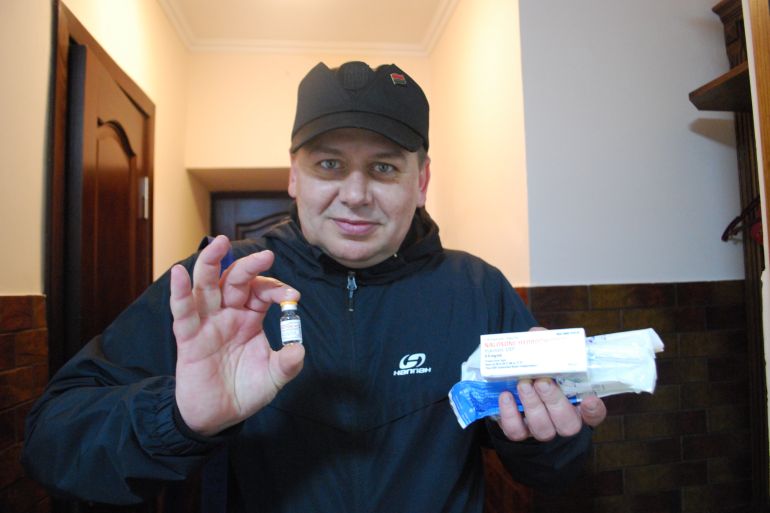
Alexey Kvitkovskiy was already far from home when he got a call about a man dying in a nearby village.
After Russia invaded in February, Kvitkovskiy fled his hometown of Severodonetsk in the east of Ukraine and settled in Burshtyn, a small town 90km (56 miles) south of Lviv. His wife and children continued on to Lithuania, far from the threat of missiles. As a man under 60, Kvitkovskiy is forbidden from leaving, though even if he were released from military service, he would choose to stay to support his particular community.
Keep reading
list of 4 itemsHow does Poland view the war in Ukraine?
Diary from Ukraine: Crossing into Poland, ‘I can exhale at last’
War deepens suffering for Ukraine’s drug users
Not long after his arrival in Burshtyn in March, the 47-year-old received a call from one of his new neighbours. They knew that Kvitkovskiy worked in harm reduction, supporting people who use drugs. A man nearby had been injecting narcotics, and he had overdosed. Could Alexey help, the neighbour asked?
“I’m coming,” Kvitovskiy said and ran to a borrowed car. Kvitkovskiy is energetic, with a round, expressive face. He sprinkles responses with a long, melodious “Taaa-aaak” (yes.) During the tense 20km (12-mile) drive, he stayed on the phone with the man’s friends, advising them to clear his airway and call an ambulance. But the apartment’s owner refused to let them, lest the ambulance also brings the police.
Kvitkovskiy, himself a former user of street drugs, is the founder of Volna Donbas, a Ukrainian harm reduction organisation. He has seen dozens of overdoses over the years. Before the war, he says, “We lived a normal life. I made plans, dreams, and worked.” That work consisted of advocating for drug users and getting them access to health services. It was challenging enough then.
Now, he arrived at a two-storey house in a small nearby town and found a thin man in his early 40s lying on his side, unresponsive.
Normally, at that point, he would administer naloxone, a medication that can rapidly reverse opioid overdoses. But with the invasion shredding supply chains, he was unable to get any through the programmes that normally supply him, and the pharmaceutical company in Kharkiv that produced it has shut down. He was completely out.
Kvitkovskiy did what he could. He began to perform CPR, including rescue breathing, on the man, who risked respiratory failure.
At last, the man regained consciousness, but within 20 minutes, he nodded out again. Kvitkovskiy revived him once more. And then a third time. “It took three hours to wake him up,” recalled Kvitkovskiy, speaking through a translator over Telegram. “It was exhausting.”

A dangerous mission
It has always been complicated to help vulnerable Ukrainians who use drugs. For Kvitkovskiy and other members of a network of harm reduction organisers, the already difficult mission has become vastly more dangerous since Russia invaded Ukraine.
It is harder to reach people due to relentless shelling. Opioid substitution therapy (OST)(PDF) medicine like methadone is harder to find. And those living in Russian-occupied territories face severe stigma and persecution.
Kvitkovskiy spoke with Al Jazeera over the course of a month, during which the stress of his work was apparent. He moved and spoke in a febrile rush, jumping from stories of one crisis to the next, eyes wide. The screenshots he shared provided further hints of his exhaustion: “I can’t talk right now,” he told a colleague, “they’re bombing Odesa.” Later: “I’m not sleeping at all.”
At times he would break off, mid-conversation, explaining that he had to support someone’s evacuation – finding a driver, raising funds. Sometimes Kvitkovskiy’s messages arrived at 6am Kyiv time, saying he was finally going to bed, exhausted.
On top of displacement, Kvitkovskiy is already familiar with the other risks war brings: in 2014, he was cut off from access to his medication for a week. In 2018, one of his colleagues was captured by Russia-backed forces and sentenced to 11 years in prison for transporting prescribed OST medication. And as an OST patient himself, he faces persecution from occupying forces.
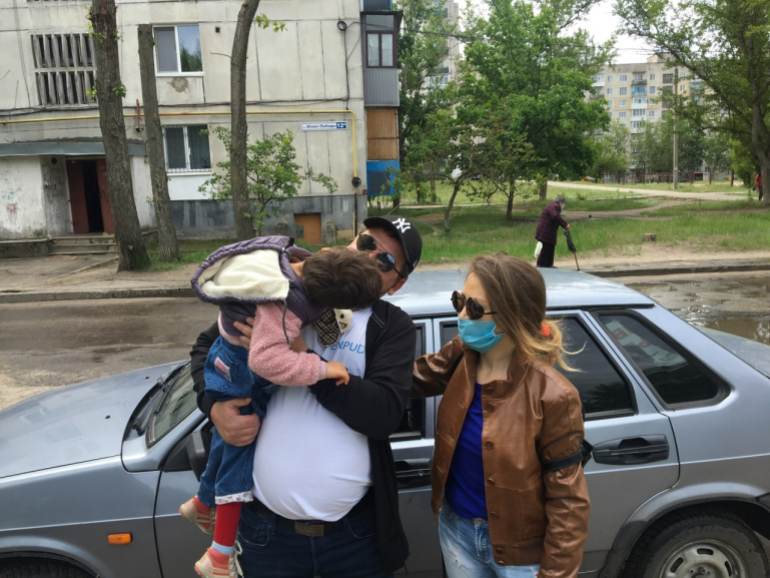
State of harm reduction in Ukraine
Harm reduction is an evidence-based public health approach that aims to minimise the negative effects of risky health behaviours. The policies inform and support people, rather than prohibit and punish. Organisers supply clean syringes, naloxone, and OST drugs, along with HIV counselling and treatment, TB testing, and many other services.
OST involves replacing unregulated street drugs with medically prescribed, orally administered ones. This reduces the risk of injection-related harms, such as HIV, hepatitis, abscess, and overdose. Methadone, a synthetic opioid, does not get OST patients high; instead, it removes their withdrawal symptoms and prevents cravings.
Even before the war, the need for harm reduction services in Ukraine was acute. Eurasia has the fastest-growing HIV epidemic (PDF) in the world, and Ukraine bears the second-largest HIV (PDF) epidemic in the region. Nearly 350,000 people inject drugs in Ukraine, and almost 250,000 are estimated to be living with HIV/AIDS, a prevalence rate twice the average of the rest of Europe. Ukraine has the second-greatest number of intravenous drug users in the region, behind only Russia.
“All time is divided into before the war and now,” Ganna Dovbakh told Al Jazeera over the phone from Vilnius, Lithuania. Dovbakh is the executive director of the Eurasian Harm Reduction Association, a nonprofit comprised of regional harm reduction organisations that advocate for the wellbeing of people who use drugs. “And before, Ukraine was one of the more successful countries with harm reduction in our region.”
Before the invasion, Ukraine had the biggest regional programme, with up to 17,000 people on OST, she said. Ukraine is also one of just three countries in the region where PrEP, a medicine for those at risk of getting HIV, is available. The cost of some first-line HIV regimens has been reduced to as little as $78 per person per year. Treatment for Hepatitis C, a liver disease often spread by sharing needles, is available for free to vulnerable populations.
Kvitkovskiy first tried heroin in 1998 in Russia. An engineer, he took a business trip to a small village outside Moscow to work on the Druzhba, the world’s longest oil pipeline, transporting oil across Europe.
“Some guys from Dagestan were playing billiards,” he recalled, speaking animatedly in a black cap embroidered with the Ukrainian coat of arms. “They needed a fourth person, so they invited me to join. Our team won, and afterwards, they said, ‘We have something you could try with us, as a gift.’ The guy prepared it in the spoon, and suddenly I felt warm: the grass was so green. The sky was so blue.”
Kvitkovskiy used street drugs until 2008, when he became an OST patient. Soon after, he came to believe that people like himself, with lived experience of addiction, were well-positioned to make life better and safer for drug users. He became deeply involved in advocacy.
Today, the outbreak of war has not only interrupted the supply of naloxone; it has also interrupted the supply of OST drugs. And when patients on OST are suddenly cut off, they risk withdrawal and relapse.
Ukrainians are already familiar with this. When Russia annexed Crimea in 2014, all OST clients in Crimea were cut off from treatment, despite desperate pleas recorded by patients. When an OST patient cannot access methadone, which Ukrainian patients would typically pick up from a nurse in a clinic, they will start to feel the effects – cravings and withdrawal – within 36 hours.
Russian methods offered instead have included beatings, starvation, hypnotherapy, brain surgery, electric shock, burying patients in the ground for 15 minutes, and “implantation of guinea pig brains”(PDF).
By early 2016, an estimated 100 of the 800 OST patients in Crimea were dead, most by suicide or overdose.
Even outside Russian-controlled areas, interrupted supply – either of street or OST drugs – leads to more frequent overdoses, as seen during the pandemic. “When there is no supply, people [develop] a reduced tolerance for drugs,” Kvitkovsky explained. “After that, if a person takes their usual amount, they can overdose.”
Despite his own displacement, Kvitkovskiy has continued to help members of the drug-using community. On April 2, he arranged for the evacuation of Zhenya, an OST patient whose home in Rubizhne, about 15km (9 miles) northwest of Severodonetsk, had been destroyed by missiles. “Her husband was killed and lay on the street for two days. No one could pick up the bodies because the front line ran through that street,” he explained over text.
With the help of Volna, the network got her out, along with her child who has cerebral palsy.
Kvitskovskiy says that grassroots organisations are more effective at arranging evacuations like these compared with major nongovernmental organisations (NGOs). “We do it ourselves. We have a very developed community of drug users, and we help each other.” Moreover, intravenous drug users may find it easier to trust others from their own community.
Programmes tend to work closely alongside the people they support. For example, before the war, Convictus, a Kyiv-based harm reduction group, offered round-the-clock services to the estimated 10,000 sex workers around Kyiv, partly by launching a mobile team each evening at 7pm. The team would visit workers, who often lack documentation and shun state-run services, at hotels, saunas, and truck stops.
Convictus also employs people from affected groups, says project manager Oleksandr Volontyr. Some have alcoholism, HIV, and tuberculosis; some are on OST. “They’re paid staff, but [since the invasion] they also provide additional humanitarian aid as volunteers,” he says. Most employees have had to leave their homes and seek refuge someplace safer. Some HIV-positive staff went abroad to continue receiving treatment. The homes of at least two staff members have been destroyed.
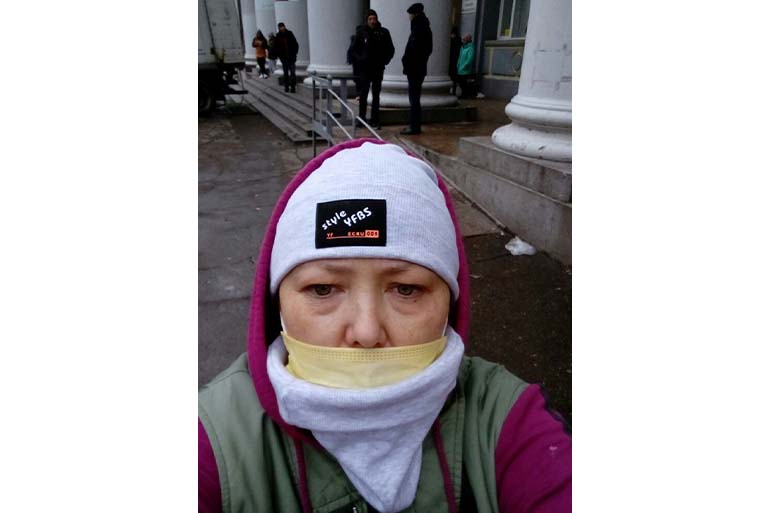
Russian prohibition and assaults
As attacks hit the last hospital in Kvitkovskiy’s hometown, the looming threat of Russian control poses a unique set of risks for people who use drugs.
In line with its punitive approach to drug policy, Russia does not offer naloxone. Harm reduction workers have been targeted in Russia-controlled regions: Natasha Zelenina has been imprisoned in Donetsk for four years for attempting to bring legally prescribed buprenorphine into the territory.
All this is in the face of Russia’s own high rates of IV drug use and sharply increasing rates of HIV and Hepatitis C among addicts who inject drugs. Between 2011 and 2016, the annual global increase in HIV prevalence was 10 percent. In Russia, it increased by 75 percent.
Since the invasion began, Kvitkovskiy has heard accounts of abuse by Russian soldiers in Ukraine. In one incident, a different woman in Rubizhne reported that Russian soldiers accosted her and took the keys to her apartment, where her mother and young son were ill. They took her money and valuables. Then they undressed the woman, and when they found pills in her bra, threatened her with rape.
The men stole her prescribed methadone. They also threatened to hand other patients over to occupation authorities. The family has since fled west.
Natalya Kaluzhskaya, 48, is the lead coordinator of Mariupol’s Volna chapter and an OST patient herself. She spoke with Al Jazeera via a translator over video from an apartment in Burshtyn where Kvitkovsky helped her evacuate. With large pale eyes and measured restraint, she described her ordeal.
Before the war, she estimates, 9,000 IV drug users lived in Mariupol. APH believes 4,700 were HIV-positive. About 300 were on OST. The OST clinic shuttered on February 28. Kaluzhskaya then had 48 pills left, enough for 12 normal days. She began to take half her normal dose: two pills per day instead of four.
A few days later, she received a call from a married couple who had been beaten and robbed of their OST drugs. Kaluzhskaya wrote to the nurse who normally distributed the medications, warning her to be careful.
On March 2, the electricity went out. Shortly after, the situation began to spiral out of control. Kaluzhskaya and her husband, Kostya, who is HIV-positive and has Hepatitis C, were trapped in their apartment in Mariupol amid heavy Russian shelling.
“We couldn’t go outside because of the missiles, and we couldn’t get any news because nothing was working: no light, no water, nothing. Everyone was alone with their own problems.” Kostya also began taking one-fourth of his prescribed dose of medication to ration it.
The couple tried to evacuate on foot but could not get out due to missile attacks. They ran into other members of the drug-addicted community, who advised them not to try to go anywhere. So they went to the basement of the Mariupol Drama Theater and remained there for two weeks.
By the second week, she could not eat due to stomach cramps. Kaluzhskaya knew what she would experience if she ran out of her medication completely: pain, fever, vomiting.
After 12 days, another woman in the basement announced that she was going to make a run for safety. The couple joined her and escaped the city.
They eventually reached relative safety in Burshtyn, where they stay with Kvitkovskiy and have access to their medication once more. Despite their own trauma, they continue to try and support their clients who once lived in Mariupol. They have only been able to reach about 20. Via Facebook, she shares information with people still in the occupied territories and helps them to evacuate. Others, she says, now come to her in Burshtyn, seeking consultations about health and addiction.
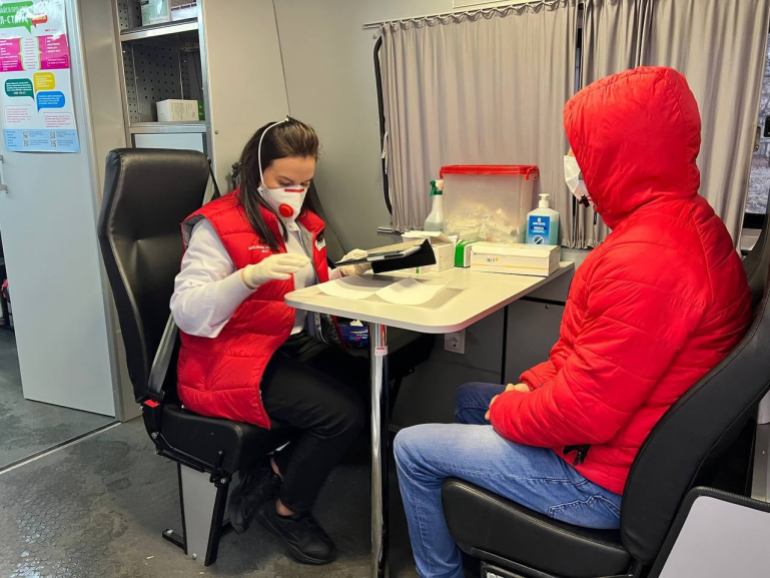
Work continues despite the risks
Despite the risks – bombing, incarceration, abuse and sexual violence – Ukrainian harm reduction workers press on.
Pavlo Skala is the associate director for policy and partnership of the Alliance for Public Health (APH), Ukraine’s biggest health NGO. The group works with more than 100 partner organisations in hundreds of towns around Ukraine.
Before the invasion, APH had 250,000 clients. About 150,000 of those were actively using injection drugs; they also supported almost 20,000 OST patients on methadone.
Now, APH runs a 15-vehicle humanitarian aid convoy which brings medicine, medical equipment, and food to anyone they can reach in hard-hit areas, like Kherson, Chernihiv, and Zaporizhia. Volunteers drive the convoy, which is comprised of former mobile HIV and TB labs. They delivered OST narcotics to the Sumy region when Russian forces were still there, though APH asked that Al Jazeera not share their methods since Russian forces would consider those deliveries punishable by arrest.
Towards the end of March, the APH situational report mourned Kaluzhskaya’s hometown, Mariupol. The report read, “No services are currently provided in Mariupol. Our mobile clinic was destroyed by shelling. Connections with most of the people in Mariupol has been lost.”
A week later, one of APH’s partner organisations was ambushed and shelled while using an APH bus to evacuate civilians from the Chernihiv area and deliver supplies. All three of the people inside the vehicle were killed.
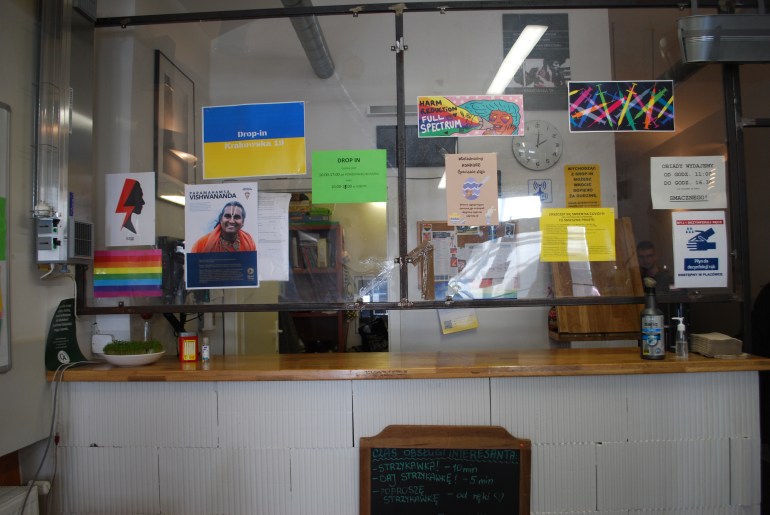
Exile in Poland
Today, any one of the more than 3 million Ukrainian refugees in Poland who may need harm reduction services face a new set of challenges.
The only drop-in clinic in Krakow, inconspicuously nestled off a street busy with blue trams, is one of just four, staff say, in Poland. When Al Jazeera visited, the clinic director Greg Wooloswki was conducting an intake interview with a Ukrainian refugee woman, learning about her needs and directing her to resources.
In the clinic’s small front area, half a dozen visitors chatted, drank coffee, and played on their phones. The reception desk was decorated with informational flyers. Behind the desk, plastic bins held clean syringes, sterile water, bandages, and other supplies for safe use.
Unlike in Ukraine, OST patients in Poland have to visit a hospital or programme site to receive medicine, rather than being able to pick it up from a pharmacy. Naloxone is also only available through emergency medical services or specialised treatment centres. And Poland has just 36 needle exchange sites, compared with Ukraine’s 1,667.
The difference in policy approach seems to have had clear effects over the last several years. Poland still has lower HIV rates, but while rates are now on the decline in Ukraine, in Poland, rates of HIV have risen “precipitously” over the last decade.
Woolowski says that Ukrainian arrivals typically seek methadone, and HIV and hepatitis treatment. But there are not so many – mostly, the staff say, displaced Ukrainians are too busy meeting immediate needs, like shelter, to attend to chronic medical and psychosocial care. This is one of the ways that dislocation typically disrupts people’s access to medical services.
Kvitkoskiy, Kaluzhskaya, and Kostya will continue to be displaced for the foreseeable future. Missiles hit Kvitkovskiy’s apartment three days after they evacuated. The school where his youngest son was preparing to start kindergarten has been destroyed.
Kaluzhskaya shared a video with Al Jazeera, taken as she sheltered in Mariupol. She paces about the Mariupol Philharmonic, around the corner from the Drama Theater. Her face, soft with exhaustion, fills the screen as she explains that although she has no signal, she is recording it “to remember if I am alive”.
“The only thing that matters is getting water,” she says into the camera, wearing a pale yellow surgical mask, weeping almost continuously.
She retreats into the dark halls of the lobby, where voices echo off stone walls. Her husband waves at the camera from the shadows.
“I’m an addicted person,” she says, “but I have to survive somehow.” She calls to people out of the frame, but they do not seem to hear her among the noises of war.